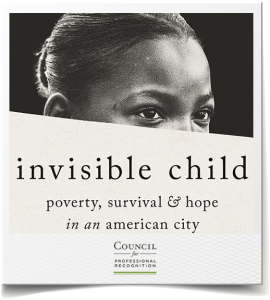 Dasani wakes up before dawn each day at a homeless shelter in Brooklyn, New York. After slipping out from under the covers, she goes to the window. On a clear day, she can see all the way across the shimmering East River to the top of the Empire State Building, the first New York skyscraper to reach 100 floors. And looking at it makes her feel like the world is full of promise. “I have a lot of possibility, too,” she says. “I have a lot of things to say.”
Dasani wakes up before dawn each day at a homeless shelter in Brooklyn, New York. After slipping out from under the covers, she goes to the window. On a clear day, she can see all the way across the shimmering East River to the top of the Empire State Building, the first New York skyscraper to reach 100 floors. And looking at it makes her feel like the world is full of promise. “I have a lot of possibility, too,” she says. “I have a lot of things to say.”
You can read them in Andrea Elliott’s book, Invisible Child: Poverty, Survival & Hope in an American City. Elliott followed Dasani for eight years to provide a ground-level look at what being a poor kid in New York is like and to explore the city’s mishandling of the homeless. Her account begins when Dasani is 11 years old and living in a shelter that is off limits to the public. Eventually, Elliott manages to sneak in with a photographer through a fire escape in the back and run past security guards to expose the conditions inside.
Elliott finds that Dasani lives in a 520-square-foot room she shares with her mom, Chanel; stepdad, Supreme; and eight younger siblings. They have a slop bucket they use as a toilet and a little sink that constantly drips, sprouting mold from a rusted pipe. Cockroaches crawl to the ceiling. Mice scurry across the floor, covered with the mattresses on which the family sleeps. The screeching of addicts and staccato sound of gunshots come in from the alley outside and fill the room at night.
The room is also filled with love and a deep sense of commitment, as Chanel makes clear. She didn’t have her children by accident. She had them by design, planning for this small army of siblings and seeing strength in their bond. “This is a cruel world,” she tells Elliott at one point. “I didn’t want my children to be hurt by the world. I wanted them to rely on each other. So, they don’t need to depend on people who aren’t family.”
That puts a heavy load on Dasani’s young back. She was changing diapers before she was in grade school. When she was in fifth grade, she became the one who fetched the baby’s bottle before dawn. By the time Dasani shows up at school she is often late, has missed the free breakfast and has been caring for her siblings for hours. Her life is hard, but she accepts it and seldom imagines anything better. “I don’t dream at all,” Dasani says, “even when I try.”
Yet she manages to reach he honor roll one fall and her teachers see promise in the slight young girl with high cheekbones, sparkling eyes and a lovely smile. The principal refuses to give up on Dasani, even when her grades fall, and her behavior becomes disruptive. A teacher named Miss Hester serves as a role model who identifies with Dasani’s problems and urges her to strive. Miss Hester began life in the projects and managed to win a scholarship to college. But she knows her example is hard to match, especially for a girl who’s so loyal to her siblings. Dasani needs to change her life and leave the shelter to become the person she could be, Miss Hester explains, and “that’s a problem if any of her family members don’t see leaving as important.”
As it turns out, the family supports Dasani when she is admitted to the Milton Hershey School, a boarding school for low-income children in central Pennsylvania. Drawing from a large trust set up by the chocolate magnate, Hershey makes life much sweeter for its students. It invests nearly $85,000 a year in each of its students, providing them with housing, medical and dental care, clothing and food, a large support staff and even college tuition on graduation. At Hershey, Dasani lives in a large home with a dozen other girls and two boys, as well as two house parents who reassure their charges that they no longer need to guard their food at meals.
Dasani thrives there as the weight of home life lifts from her slender shoulders. She raises her math scores, becomes a cheerleader and makes the track team. Yet she struggles with code switching, the ability to shift between the behavior and language of different places so you can move within all of them. Dasani wonders why she has to dress in a certain way and say isn’t instead of ain’t. She feels that she’s rejecting the culture of the place she calls home. And this sense of conflict grows as her family begins to crumble.
While Dasani is at Hershey, Chanel secures a housing voucher that stabilizes rent, and the family moves to a Staten Island apartment with several bedrooms. All is well for short while. Then her seven-year-old brother runs away. Child protective services bars Chanel from the home for suspected drug use so she has to sleep outside. Bureaucratic lapses leave Supreme without basic needs like food stamps and getting the electricity back on. When Supreme runs out of food, he grabs a new roll of paper towels from the apartment, heads to a nearby store, and tells the clerk, “I will kill you if you don’t buy these paper towels.” After he’s arrested, all eight children, even Dasani though she’s away, wind up in foster care. The family Dasani loves is no longer there when she goes for visits to New York.
And this is not the way the system is supposed to work, as Elliott points out. The goal of the NYC Administration for Children’s Services is to “stabilize families at risk of crisis” through therapy and parenting classes, as ACS states on its website. Yet the federal government makes this hard. ACS currently spends about $532 million a year on foster care, more than twice what it spends on preventing families from falling apart. Around 44 percent of its budget relies on federal funds, of which the lion’s share goes to foster care—not prevention. What results is a “policing system,” Elliott contends, “that disproportionately punishes families who are living in poverty and families of color”—like Dasani’s.
The family’s breakup also puts a halt to all the progress she’s made during two years at Hershey. Visits to the different homes where her siblings live make her feel guilty for going away. Dasani is anxious, a feeling that’s especially bad for poor kids who have long lived with the chronic stress brought on by exposure to violence, hunger, sleep deprivation and illness. A child like Dasani can get stuck in a “fight or flight” mode leading to overproduction of cortisol, a hormone that makes it harder to cool down when you’re upset. Dasani begins getting in fights and bloodies another girl’s nose, leading to her expulsion from Hershey.
When Dasani gives Chanel the news, Chanel tells her that there is no more home and Dasani will have to go into foster care. But for Dasani “home” is the people she loves, not a place. “It doesn’t have to be roof over my head,” she explains. “At Hershey, I feel like I’m a stranger, like I don’t belong. In New York, I feel proud. I feel good, and I feel accepted.” She wants to feel at home and be free to talk the way her sisters do without always hearing the voice of correction. So, she’s glad to return to Brooklyn and go back to public school. Within a year, she has buckled down and become motivated enough to apply for college.
Elliott’s book ends there, but the story of Dasani and her family wasn’t over. The family was reunited after a long battle in court and now lives in a rental in the Bronx. Both Chanel and Supreme are working for UPS, and Dasani became the first person in her immediate family to graduate high school. She’s now studying business at a community college, feeling hopeful about her life, and hitting milestones that no one in her family has before. “She’s creating life on her own terms,” Elliott says, “and that means keeping her family in her life while also taking strides ahead.”
The struggles she faced to get to this point are far from unique since Dasani belongs to an “invisible tribe” made up of thousands of poor children throughout the country. They remain in the shadows because children are seldom the face of the homeless. They spend their lives in and out of shelters, grow up with troubled parents and often raise their siblings. These crushing burdens hold them back, but many of the children have promise. Their stories also deserve attention and should make us look for kinder solutions to their problems. We need to spend more on programs that keep families together instead of tearing them apart. And we must find better ways to help homeless children reach their potential, Elliott pleads. Like Dasani, many of the children look out the window each day and believe something better is waiting for them out there.

 Dasani wakes up before dawn each day at a homeless shelter in Brooklyn, New York. After slipping out from under the covers, she goes to the window. On a clear day, she can see all the way across the shimmering East River to the top of the Empire State Building, the first New York skyscraper to reach 100 floors. And looking at it makes her feel like the world is full of promise. “I have a lot of possibility, too,” she says. “I have a lot of things to say.”
Dasani wakes up before dawn each day at a homeless shelter in Brooklyn, New York. After slipping out from under the covers, she goes to the window. On a clear day, she can see all the way across the shimmering East River to the top of the Empire State Building, the first New York skyscraper to reach 100 floors. And looking at it makes her feel like the world is full of promise. “I have a lot of possibility, too,” she says. “I have a lot of things to say.”